CAN YOU HEAR ME SPOILING?
Five of my friends were in the audience at San Diego ComicCon on Thursday watching he panel of the Inglorious Treksperts. Apparently, ROBERT MEYER BURNETT, one of the panelists, had already watched the sixth episode of STRANGE NEW WORLDS and commented, “Trek is dead after last night.”
So I sat down to watch “Lost in Translation,” this past week’s episode, expecting the first real clunker of the season. I braced myself and warned my family about Rob’s comment (as I watch this series with both my wife and my almost 13-year-old son Jayden.) And let’s face it, the series was probably due for a stumble after five very strong, very enjoyable episodes in a row so far this season. Maybe this would indeed be my first negative review of the season?
Spoiler alert: this is NOT going to be a negative review, folks.
In fact, Rob’s comment left not only me scratching my head but also my friends at ComicCon (who watched the episode later on that night) scratching their heads. And when the episode ended, my son Jayden jumped up and shouted, “How could that guy in San Diego not have liked this episode??? It was so good!” And even my wife, who has never been a Trekkie, said she enjoyed it and is generally enjoying the series…although she liked last week’s human Spock better than “normal” Spock.
I wasn’t at the ComicCon panel, so I don’t know the specifics behind Rob’s statement. But I’ve noticed other fans—albeit an observable minority on social media—espousing similar lamentations about the demise of Star Trek as they complain about the shortcomings of this show (and often the other new-era streaming Trek series from CBS Studios). I’ve read and heard many of their complaints. And it got me wondering…
Why aren’t I complaining, too?
For those of you who’ve read my many, many editorial reviews over the past half-decade, I’ve been both positive AND negative about the various new series, depending on the quality of the episode. I’ve certainly had my issues with the writing and continuity breaches on STAR TREK: DISCOVERY. But there are continuity breaches on SNW, as well, and yet they aren’t bothering me nearly as much. Why?
And while I’ve certainly been more positive about PICARD than Discovery, I’ve had my issues with that series, as well…mainly the first two seasons. SHORT TREKS didn’t thrill me at all. I’ve pretty much loved LOWER DECKS since it debuted, and although it took me four or five episodes to get into PRODIGY, I grew to really like that series, too. But I do complain when I feel it’s merited.
And I certainly thought that the revamping of the Gorn on SNW is problematic, and killing off Hemmer pissed me off. But aside from that, it’s steady as she goes when it comes to SNW.
But again…why? Why are others complaining and I’m not?
OVER TIME, STAR TREK HAS EVOLVED FROM STORY-DRIVEN TO CHARACTER-DRIVEN
Back in the 1960s, Star Trek TOS was very driven by story. That’s not to say that we didn’t have some powerful moments, like when Kirk has to stop McCoy from saving Edith Keeler in “The City on the Edge of Forever” or when Spock and McCoy argue over who will pilot the shuttlecraft into the giant space amoeba in “The Immunity Syndrome.” But other powerful character moments are glossed over, like when Kirk’s brother Sam is found dead in his home on Deneva in “Operation: Annihilate!” and Captain Kirk barely mourns at all.
Add to this that TOS never really gave us a lot of backstory on the characters. We learned the most about Kirk in the episodes like “Obsession” (he served as a lieutenant on the Farragut), “The Conscience of the King” (he was on Tarsus IV during Kodos the Executioner’s purge of half the colonists), and the second pilot episode (back at the Academy, Kirk was a walking stack of books with legs). Oh, and of course, there was Finnegan and various woman from Kirk’s past. We learned the most about Spock’s history in “Amok Time” and “Journey to Babel” (plus his prior relationship with Leila Kalomi in “This Side of Paradise.” And aside from his being from Georgia, we learned almost nothing of McCoy’s background…only being told about his daughter Joanna in the animated series.
As for the rest of the bridge crew, fans learned almost nothing about the backgrounds of Sulu, Uhura, Scotty, and Chekov…other than Scotty being from Scotland and loving technical journals (and drinking a lot), Chekov being from Russia and having had a relationship with Irina Galliulin back at Starfleet Academy, and Sulu being into guns, fencing, and botany. And we were told Uhura’s name means “freedom” and that she speaks Swahili. Considering that TOS had 79 episodes, we were given precious little backstory on the main characters, as the focus was usually more on the story being told.
Next Gen began to change that when MICHAEL PILLER took over as executive producer in season three and told the writers to shift their focus from alien/problem-of-the-week to the characters, although the stories were still important. But each plot needed to be about at least one of the crew. Deep Space Nine took things even further in character-focused stories, creating multi-seasonal arcs like Sisko’s relationship and eventual marriage to Kassidy Yates and Gul Dukat’s shifting allegiances. Voyager and Enterprise were, perhaps, a bit less character focused.
But remember that those Paramount-produced series mostly had 26 episodes per season to tell their characters’ stories, so there wasn’t a need to go overboard during any one story. Strange New Worlds, on the other hand has only 10 episodes a season to work with, so it has to squeeze in a LOT of character development into each episode. Again, there is still story, but it’s evolved a bit. It used to be that a story would bring out a minor aspect of a character or their background that we might not have seen before—like Worf’s parents, Data trying to create an offspring android, or (shudder) Beverly getting in “touch” with a ghost from her grandmother’s past. But the stories and character elements usually dovetailed.
During this episode of SNW, however, I noticed that, rather than the storylines driving the character details that would be revealed, the process appears to be reversed. It seemed that there were important pieces of background information to convey about the characters, and so the story was structured in order to best convey them.
Let’s review some of the new facts we learned about certain characters this episode and weather or not they tied into the main story:
Uhura – We already knew that she was an overachiever, but now we know how much she’s really pushing herself (not sleeping). This is, of course, story-related, as her hallucinations/visions are initially misdiagnosed by Dr. M’Benga as deuterium poisoning exacerbated by lack of sleep.
Other elements of Uhura’s character, however, had almost nothing to do with the overall plot. For example, she obviously misses Hemmer, with whom she was close professionally, and because of that, she hasn’t even spoken to Pelia until this episode. (Uhura can’t handle death well.) And then later we were reminded that her parents and brother were killed in a shuttle crash (first revealed in the pilot episode). We also found out that she was born in Kenya, had a cat named Kamile (sp?), and her first memory was watching father play piano. None of those details was necessary to resolving the main story, but the story itself opened the door for those details to be revealed.
James Kirk and Sam Kirk – Let’s start with older brother Sam, who (for whatever reason) has been totally underutilized as a character until now, appearing in only half the episodes. And even then, he’s usually doing only a brief blink-and-you’ll-miss-him cameo. But maybe that’s the point. Jim is the star of the family, and Sam is the forgettable one, or at least Sam thinks so. Y’see, we now know that Sam and Jim both have daddy issues, but Sam’s seems to be more problematic. He has his father’s name, George, but chooses to go by his middle name Sam instead. And apparently, George, Sr. isn’t exactly impressed with a son who went into xeno-anthropology and is barely rising through the ranks. He is much more impressed with the younger Jim, who is about to become the youngest first officer in Starfleet history…breaking his father’s record on the U.S.S. Kelvin.
What does any of that have to do with the main storyline about the trapped deuterium aliens trying to send a message through Uhura’s mind? Absolutely nothing! But it does help turn this previously almost-invisible crew member into a much more interesting character, doesn’t it?
For James, we find out that his dad remained in Starfleet after James was born, and he and his mother and brother spent Kirk’s entire childhood chasing his father from one posting to another, barely ever seeing him. When Jim asked his mother why, she answered, “He’s helping people who really need it.” And so young Jim told himself that if his dad chose helping total strangers over being with his family, then it must be important. This gives us an amazing insight into who James Kirk is and why he (ultimately) does what he does. But it’s not related at all to the main story. And that’s fine, by the way. I’m just pointing out the evolution of Star Trek storytelling, as TOS would seldom if ever add such an extraneous character detail to a script about something completely unrelated.
Pelia – She can “smell” trouble and apparently has no problem disobeying orders when she knows she’s right and her superior is wrong (not sure how I feel about that yet). She used to teach Hemmer and Una. I’m guessing she taught almost everyone on the Enterprise if she was an instructor at Starfleet Academy for a while…at least the crew members who took engineering classes. I wonder how it feels to have your former teacher working on your starship. I guess Una is finding out. Speaking of which…
Una – She got a “C” grade in Starship Maintenance 307, which Pr. Pelia taught (since Pelia was teaching at the Academy since before Una was even born!). But that’s not what’s really bothering her about Pelia. Nor is it the fact that Pelia is sloppy, doesn’t respect protocols, is too loose with discipline, doesn’t follow orders unless she feels like it, and she has crumbs on her uniform. When did she even eat??? (Great scene, by the way.)
Oh, quick interruption! Apparently, 300 years after the 1960s, the future is still using terms like “hippie” and “gas station.” I should be complaining about how ridiculous it is to think that the future still has gas stations (although it does still have hippies—I just didn’t know they were called that). However, I’m letting it go because I’m enjoying the series so much.
Okay, back to my original train of thought. Una’s real problem with Pelia isn’t the fact that “space hippie” is the polar opposite of the strict, disciplined approach to duty espoused by the fastidious and precise Number One. No, it’s that Pelia replaced Hemmer, and every time Una sees Pelia, it dredges up the sadness of Hemmer’s loss. Again, not really related to the main story, although you could argue that Una and Pelia’s friction was a B-story of sorts. But the point is that it once again was character development driving the episode more than story. Sure, there was still story, but the weight on the balance is tipped more toward the character end when it comes to this series, and that is an evolution for Star Trek from the old TOS way of doing things. And if some fans want the old ways back, well, it appears that SNW has moved on from them.
THE DREADED “SITTING DOWN AND TALKING” SCENES!
There’s a philosophy in screenwriting that you should avoid “two people sitting down and talking” scenes at all costs. The reason is that such scenes bring the action to a screeching halt. That said, they can also provide an amazing opportunity for plot exposition and/or revealing character details that wouldn’t come out otherwise.
There are actually two different kinds of “sitting down and talking” scenes. One is just that, where nothing is really accomplished other than characters sharing with each other. However, there is also the “two characters talking while getting something accomplished” scene. As an example, the TOS episode “The City on the Edge of Forever” is loaded with scenes of Kirk and Spock just talking to each other. But rather than sharing details about their backgrounds or feelings (although there is a little of that as Kirk reveals that he’s falling in love with Edith Keeler), most of the time, Kirk and Spock are working to solve problems: where to stay, where to look for McCoy, how to look for McCoy, and figuring out what McCoy did to change history. In almost all of their scenes, either Kirk or Spock or both of them is/are doing something like building the world’s first nmemontic memory circuit out of stone knives and bearskins, cleaning up the 21st Street Mission, drinking coffee, etc.
Now, compare that to the many, many “two people sitting down and talking” scenes” this episode presented us with (all intended to provide character background and development rather than advancing the main plotline)…
- Uhura and Pelia in the nacelle (they haven’t talked since Pelia came on board)
- Una and Pelia on the station (three scenes…mostly arguing)
- Sam and James a the bar (establishing backstory)
- Spock and Christine playing chess (moving forward the relationship subplot after last episode, not the main plot)
- Kirk and Uhura at the bar (yeah, he’s hitting on her)
- Kirk and Uhura in her quarters (this scene morphs into problem-solving, so it becomes plot-related)
- Pike and Uhura in Pike’s ready room (Kirk enters this scene midway through, changing its dynamic)
- Kirk and La’an in the corridor (providing some follow-up to the time travel episode and La’an’s attraction to Kirk…not part of this episode’s main plotline)
- Uhura and Kirk in her quarters again (talking about death, but it isn’t until Kirk leaves to get a cookie that Uhura has a breakthrough moment)
- Una and Pelia on the shuttle (bringing their one-episode conflict arc to a resolution)
- Kirk and Uhura in the bar (wrapping up the episode, Sam comes over and changes the dynamic, then Spock shows up).
Oh, and speaking of Spock showing up…!
WHEN JIMMY MET SPOCKY
The blog’s getting a bit long, but I can’t end this review without talking about the most momentous scene of the episode: when Kirk first meets Spock. But there was so much more to it than just that.
This is actually the first time in the series that the “real” James T. Kirk (the one from this timeline) steps foot on the Enterprise. We did saw his face on La’an’s PADD at the end of episode 3, but Kirk was on the Farragut when she called him. Kirk is immediately impressed with the flagship, although that seems an odd thing to say 1) just from looking around the transporter room, and 2) isn’t the U.S.S. Farragut the same kind of ship? But I ignored it. I was curious to see Paul Wesley’s take on Kirk again.
And this is where I need to state for the record that I’m one of those fans who doesn’t mind Paul Wesley as Kirk. With the exception of not being able to not see JIM CARREY playing Kirk on In Living Color whenever I watch Paul Wesley, I’m actually enjoying his Kirk. No, it’s not Shatner. Only Shatner can do Shatner. But this is a Kirk I’d like to get to know a little more.
And indeed, that’s what the character-focus of this series is offering us: the chance to get to know these characters better…and reasons for doing so. This Kirk is still at a point where he is driven to advance his career at warp speed. This Kirk is confident and brash but not yet the head-honcho. He still needs to earn his stripes (literally). And this Kirk doesn’t know Spock yet either.
In this way, this episode was actually pretty special. Granted, some fans might feel that there is too much Kirk on this series about Pike. And maybe that’s true. On the other hand, while this series is giving us ample Spock, Uhura, and Chapel, this might also be our only chance to see the evolution of Kirk, as well…except that he’s not assigned to this ship. He’s on the Farragut.
So if the writers want to give fans some Kirk—and really, why shouldn’t they?—then they needed to get him onto the Enterprise eventually…and this episode was it. Thanks to the line from the TOS episode “The Menagerie, Part I” when Commodore Mendez asks Kirk, “Have you ever met Chris Pike?” and Kirk replies, “We met when he was promoted to Fleet Captain,” the writers needed to make certain that Pike got a (temporary) promotion to Fleet Captain…at least for this mission. Yay, canon saved!
But now we’ve also established that Kirk will be the new first officer of the Farragut. Granted, we were told in the TOS episode “Obsession” that the Farragut was destroyed by the vampire cloud creature, but maybe it was only “mostly destroyed” and not “completely destroyed.” When a starship is completely destroyed, there’s only one thing you can do: go through the wreckage and look for loose dilitium. (Sorry, Princess Bride moment.)
Anyway, since we know Kirk was the youngest person in Starfleet history to be promoted to captain, it makes sense that he’d be the youngest to make first officer, too. And honestly, six years as a commander seems a reasonable amount of time before receiving that third arm braid.
And so we have Kirk’s first meeting with Spock at the end. Now, would I have liked to see more of their first conversation? Totally! But despite that minor frustration, this series can build from that moment onward, and I’m looking forward to seeing what develops.
And that, my friends, is why I’m not complaining. These writers have chosen their course: episodic stories with character-driven subplots linking them together. And the characters are fun and likable. And while the stories might indeed be taking a secondary priority to the characters, there’s still a reasonably balanced ratio. So I’m getting good characters AND good stories.
What is there to complain about?

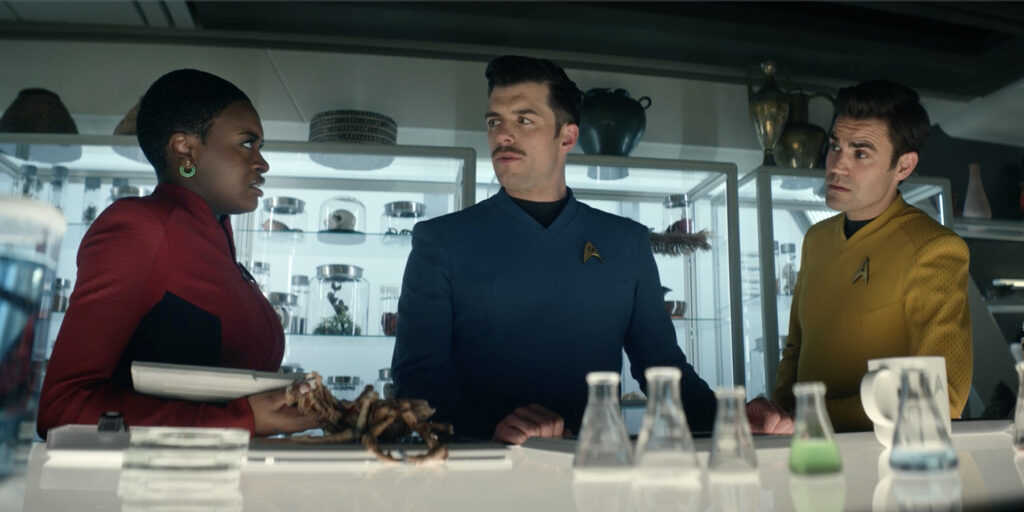
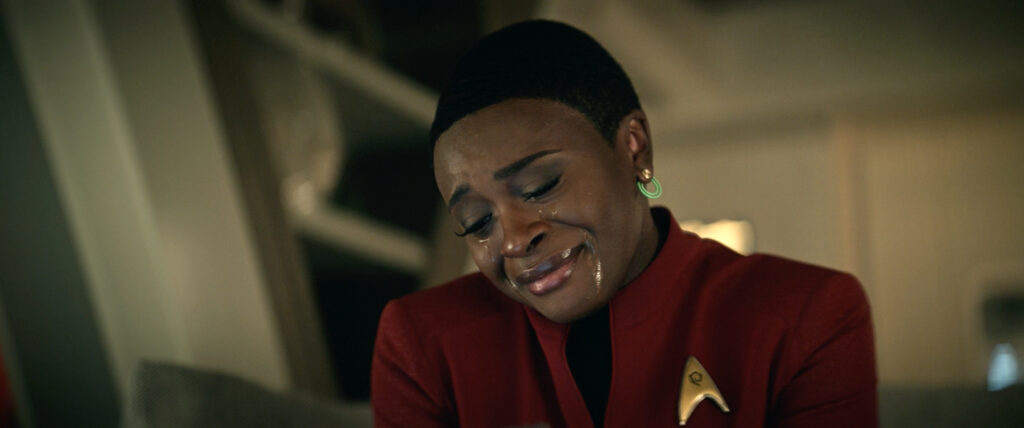
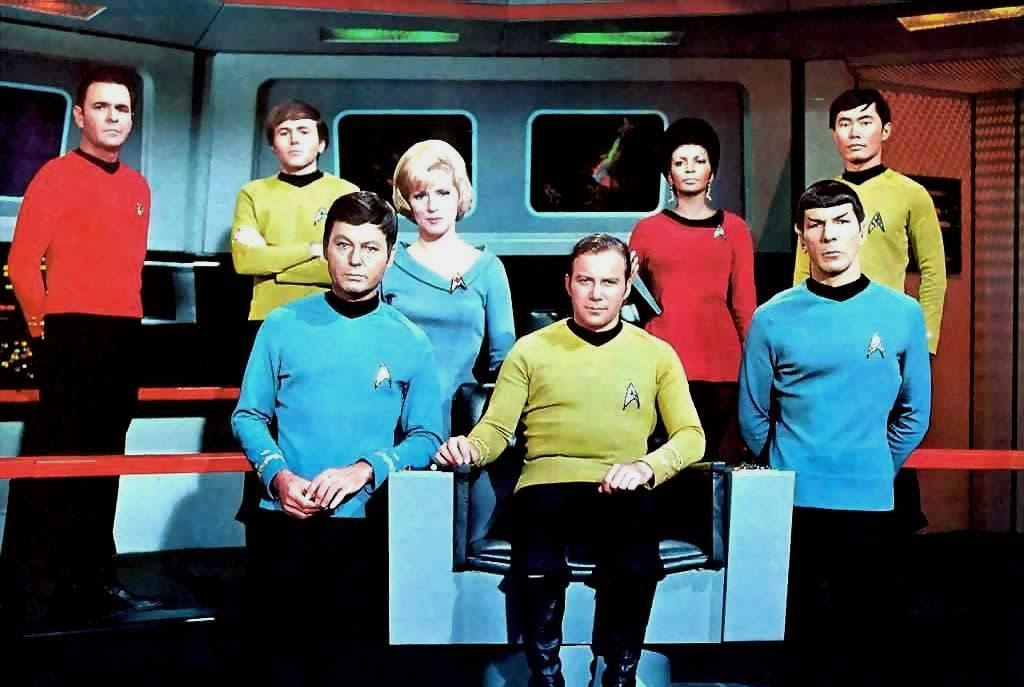
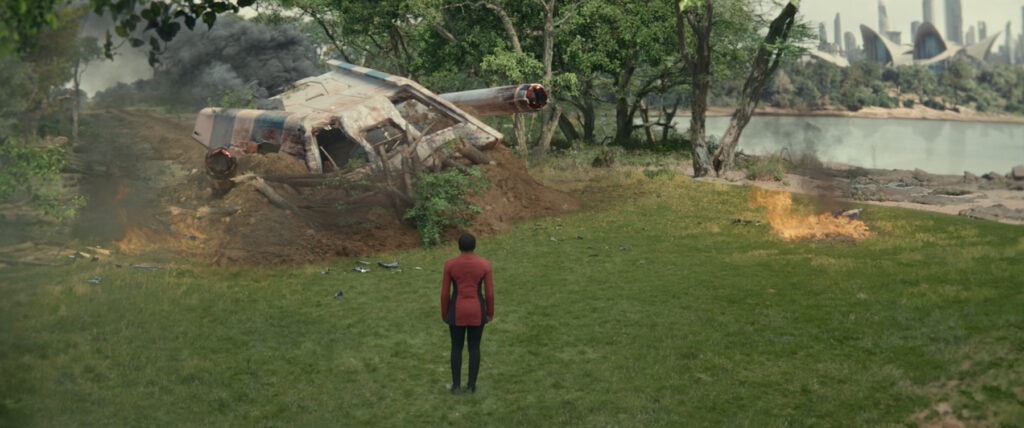
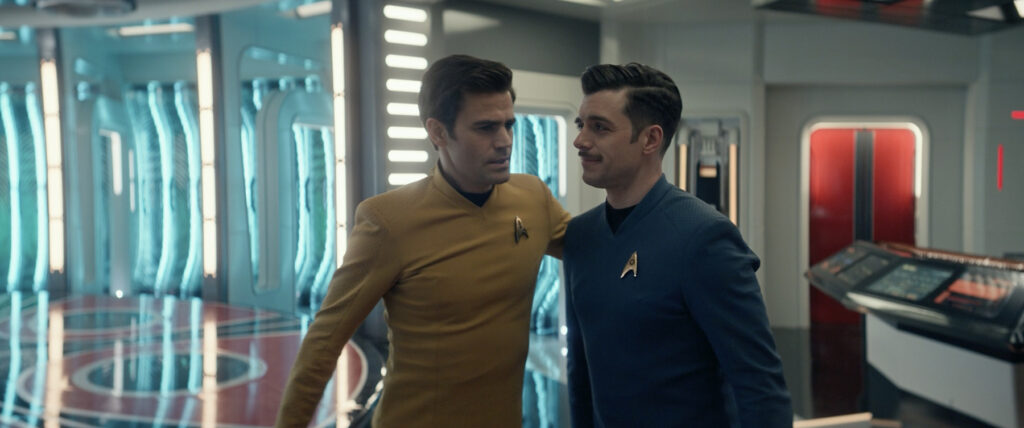
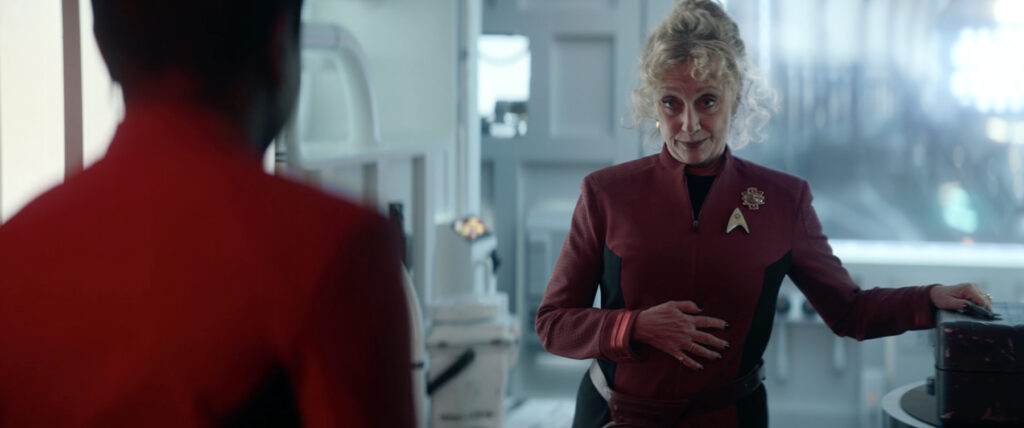
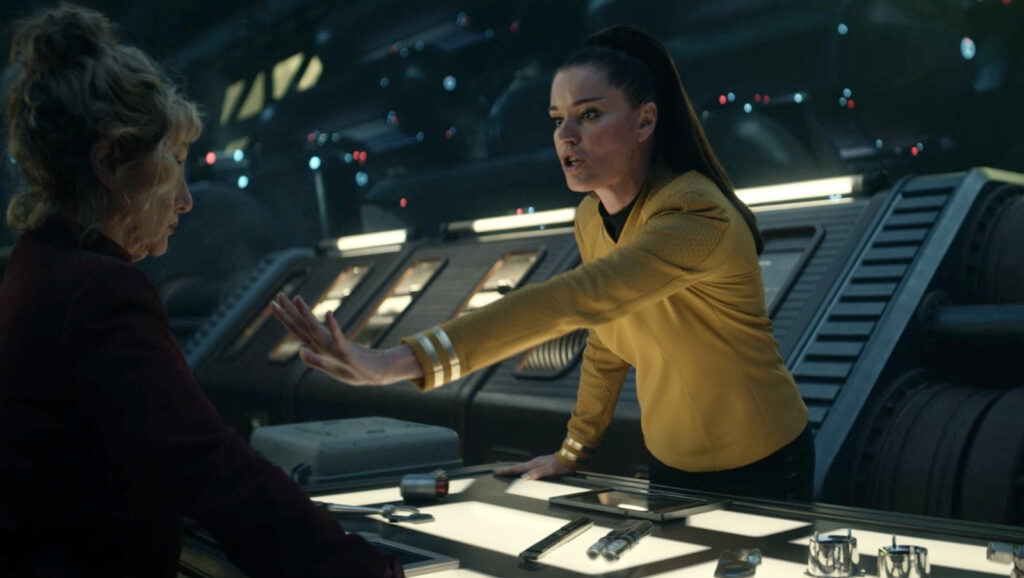
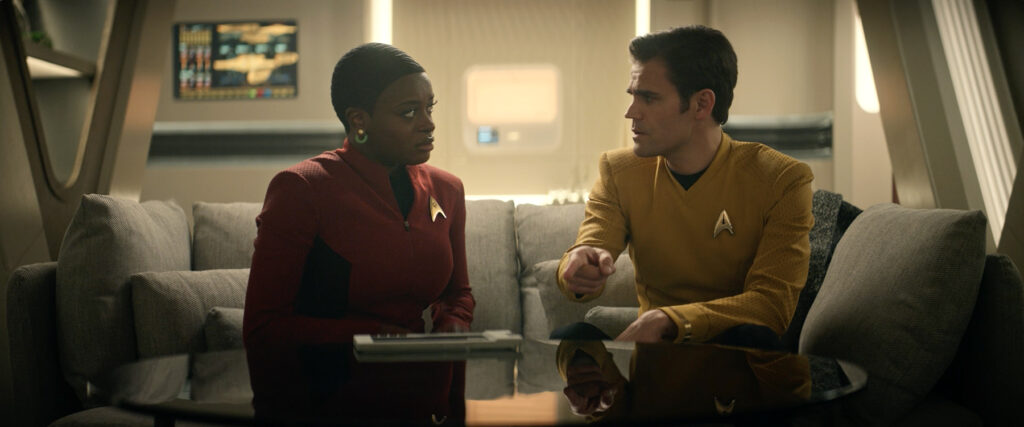
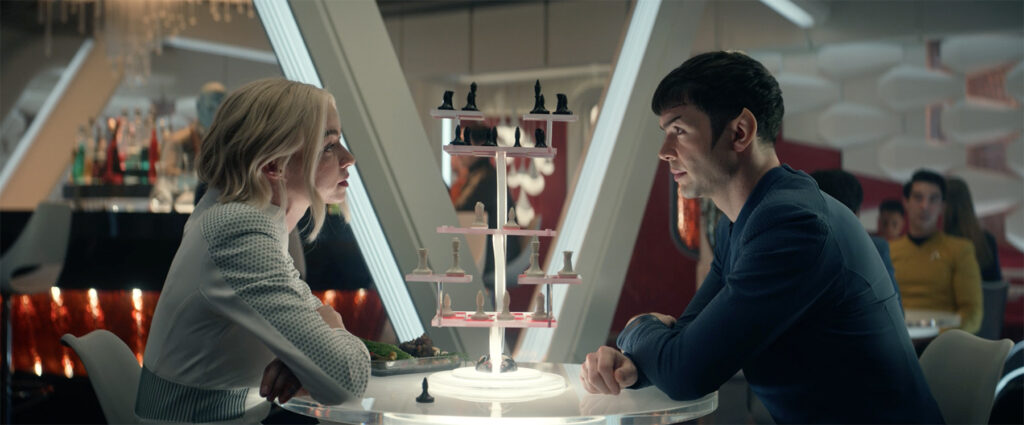
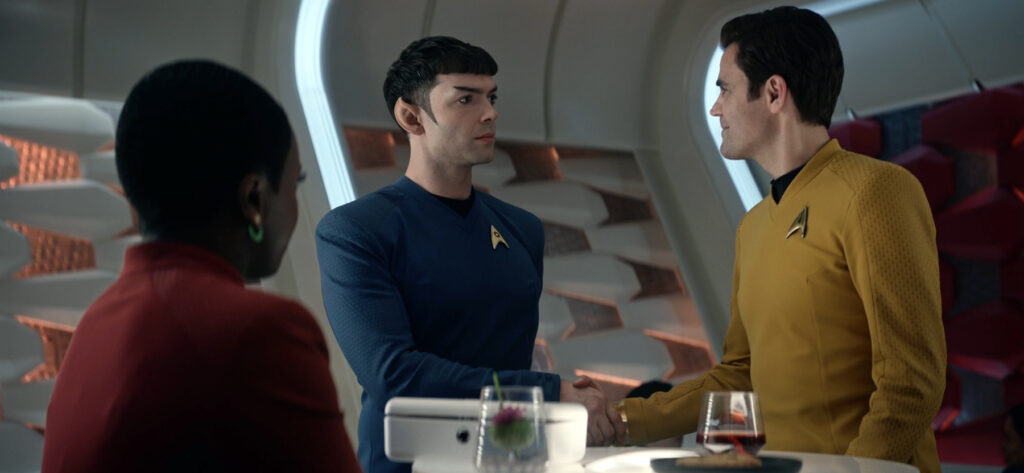
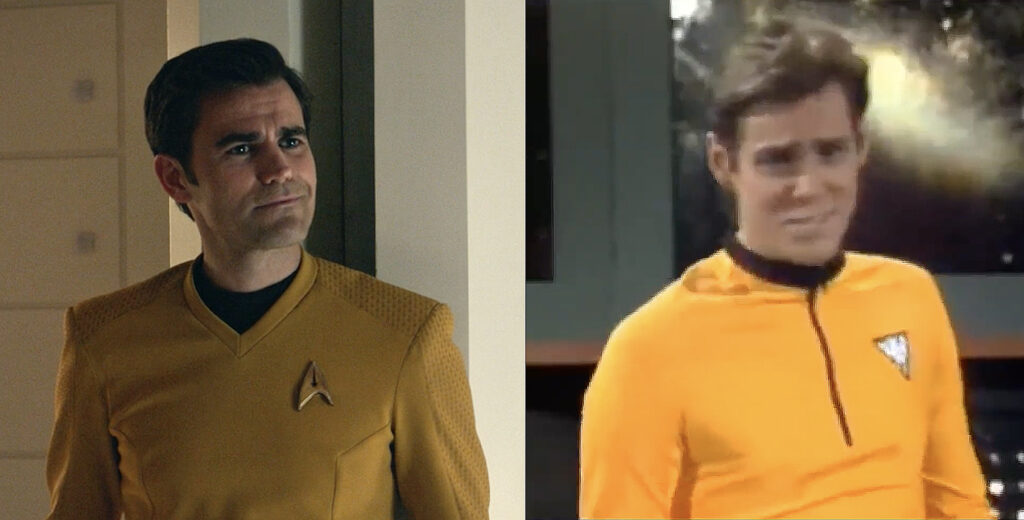
Jonathan….you know my feelings on SNW since we have talked about my essay and as to the last episode ‘TOS’…it was excellent! I had tears in my eyes! I’m still not a total fan of Strange New Worlds or Lower Devks but that episode was AMAZING!
Well, I’m working on my review editorial for that one right now! Glad you loved it.
” Yay, canon saved!” Thanks, I spit my coffee out at that one! Eye roll here! When I look at Wesley, I think to myself, where’s the beef? Maybe they could add some padding to his skinny A**? At least Pike looks like he can handle himself! As for RMB’s complaints, I think he’s gone overboard just a tad. I’m not hating this series, but, I’m not exactly thrilled with it either. My biggest gripe is it seems more soap opera, than Syfy story most of the time. Which is telling, for writing staff these days. Too much of who’s feelings are what each episode. At least the crossover episode this weekend (a surprise) came out early, wasn’t too bad, except for the neurotic, lower Decks pair, from the future. More lack of discipline crew members. And while I’m on that, since when do junior officers give orders to fire torpedoes, and the Captain seconds it??? SMDH
Well, I did say this series had shifted to more character-driven scripts, so that’s likely why you’re getting the soap opera vibe.
As for Uhura ordering photon torpedoes, I noticed that, too. And Pike did give a nod. I think the writers were trying to give Uhura the heroic moment in the episode. Did it work? Kinda. I think the moment would have been less powerful had Pike ordered the torpedo fire, but it would have been more realistic. You’re correct that no ensign would ever order photon torpedoes to be fired when the captain is standing right next to her. But I forgive such things because the show is so enjoyable.
Once again, I find myself agreeing with almost everything you’ve written. 🙂 My Wife and I are genuinely enjoying SNW each and every week. We also both like the character-development aspects, as well. The only exceptions have been the overly gory Gorn stories last season. 🙁 So far, so good, at not seeing them again all season (so far!) I was concerned with them being the cause of Uhura’s frightening hallucinations and that “droning sound” that only she was hearing. It was cool to learn that it wasn’t Gorn, but some other alien in the nebula! (How many nebulous (sorry/not sorry) aliens have we been introduced to, now?) 😉
It was a great episode in what has been a series of great episodes this season!! I will be sad when the last one airs, as there will be no more, until….??? 🙁
Don’t be too sad when the last one airs. We’re long overdue for the Gorn to return, and I suspect that the finale following the musical episode will leave us all seeing green.
I hope not. We got an unpleasant dose of gory scenes in this “flashback to war” episode that just aired. Yes, it emphasizes the fact that WAR IS HELL alright. 🙁
Just a quick thought on “Those Old Scientists”… My Wife and I ABSOLUTELY LOVED IT!!! Of course, it was directed by Johnathan Frakes! It even took a few opportunities to “fix” some inconsistencies in canon that we have seen so far. NICELY DONE! 🙂
Often I see praise and complaints really being about personal preference. Some people like one sort of story and other another preferring stories with a particular focus.
Some like magic and God-like powers and we’ve had those episodes. (whatever happened to Trelane?) Some like gadgets and we’ve had stories focusing on that. Some like plot twists and we had Moriarty being tricked by a ship in a ship in a bottle. And some like character and we’ve had stories “shippers” like. Some focus on SF humor. Some action-adventure. And some horror which I personally will avoid watching. And very soon we’ll have “Star Trek: the Musical”.
Most episodes manage to blend more than one but as you pointed out with a different emphasis depending on the series and the episode. My personal tastes are pretty eclectic so the different focus does not bother me in the least. As long as there is a good script, the actors are firing on all cylinders and the director is up-to-snuff I’m most often very happy.
As far as canon goes, when there is a violation that smacks of failure to do research I tend to be bugged. When there’s a very important plot reason (Organian peace treaty disappearing) I’m ok but I’d like a nod to why canon was broken.
I suspect I’m not alone in these sentiments.
No, Jerry, you’re not alone. Canon can be a cruel and heartless mistress, trapping your story in a place that often prevents it from working. So the writer is left with a choice of either violating canon or having to waste valuable screen time explaining the inconsistency. I try to keep an open mind about canon violations and not necessarily hold them against the creators. That said, whoever decided to create bald Klingons with four nostrils needs to be taken onto the port nacelle and shot! 🙂